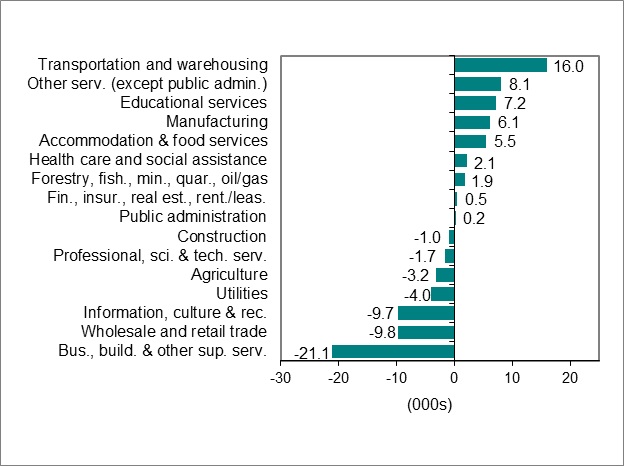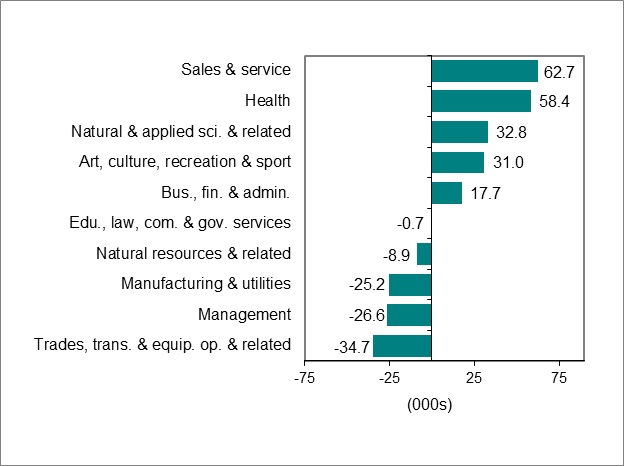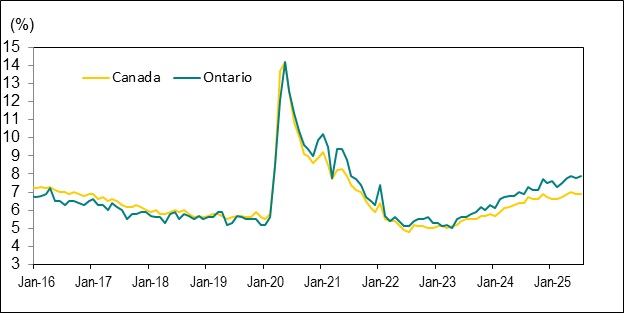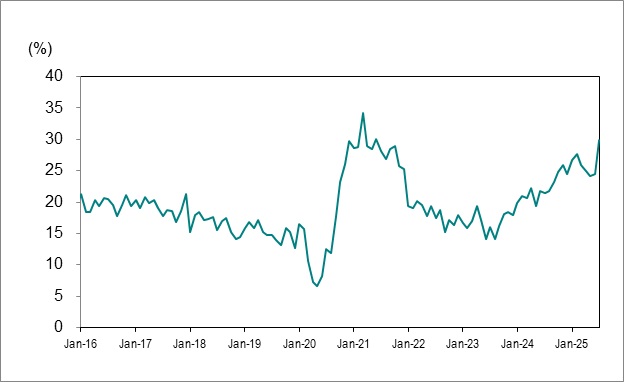Labour market report, July 2025
Employment in Ontario was little changed in July. Get the details in this report.
Quick facts
In July 2025:
- There were 13.7 million people in Ontario aged 15 years or older:
- 8.9 million (65.0%) were in the labour force. The labour force increased by 2,300 (0.0%) in July compared to June.
- 8.2 million (59.9%) were employed, little changed from June (-2,800 or -0.0%).
- Ontario's unemployment rate increased to 7.9% in July from 7.8% in June and 700,500 people were unemployed, up by 5,200 (0.7%) from June.
Important note:
This report is based on the Labour Force Survey (LFS), a household survey carried out by Statistics Canada. June’s LFS results cover labour market conditions during the week of July 13 to 19.
NOTE: LFS data reflect initial tariffs on exports to the United States including goods not compliant with the Canada-United States-Mexico agreement (CUSMA) (March 4), steel and aluminum (March 12), automobiles (April 3), and auto parts (May 3).
Employment little changed in July
Employment in Ontario was little changed in July (-2,800 or -0.0%), after increasing by 21,200 (0.3%) in June. A total of 8,217,000 people were employed in Ontario in July.
Employment in Canada decreased in July (-40,800 or -0.2%), after increasing by 83,100 (0.4%) in June. A total of 21,020,400 people were employed in Canada in July.
Chart 1 shows employment in Ontario from January 2016 to July 2025.

Source: Statistics Canada, Labour Force Survey, Table 14-10-0287-01, (seasonally adjusted data).
Full-time vs. part-time
Full-time employment increased by 21,200 (0.3%) in July, while part-time employment decreased by 24,000 (-1.6%).
Employment change by sex and age
Employment for men decreased by 20,200 (-0.5%) in July, after increasing by 11,300 (0.3%) in June. Total male employment was 4,328,200 in July. Employment for women increased by 17,400(0.4%) in July, after increasing by 9,800 (0.3%) in June. Total female employment was 3,888,800 in July.
Youth (aged 15 to 24) employment decreased by 1,400 (-0.1%) in July for a total of 1,047,800, after decreasing by 10,400 (-1.0%) in June. Employment for people aged 25 to 54 decreased by 12,400 (-0.2%) in July to 5,452,500, after increasing by 30,600 (0.6%) in June. Employment for those aged 55 and older increased by 10,900 (0.6%) in July to 1,716,600, after increasing by 1,000 (0.1%) in June.
Employment change by industry
Ontario’s largest industry groups by employment in July were wholesale and retail trade (1,156,000 or 14.1% of total employment), health care and social assistance (1,021,400 or 12.4%), professional, scientific and technical services (917,900 or 11.2%) and manufacturing (811,000 or 9.9%).
Business, building and other support services (-21,100 or -7.6%), wholesale and retail trade (-9,800 or -0.8%) and information, culture and recreation (-9,700 or -2.8%) led job losses in July.
Notable job gains in July included transportation and warehousing (16,000 or 4.0%), other services (except public administration) (8,100 or 2.9%) and educational services (7,200 or 1.2%).
Chart 2 shows industries by employment change in Ontario, June 2025 to July 2025.

Source: Statistics Canada, Labour Force Survey, Table 14-10-0355-02, (seasonally adjusted data).
Employment change by occupation
Ontario’s largest occupational groups by employment in July were sales and service (1,782,000 or 21.5% of total employment), business, finance and administration (1,378,200 or 16.6%), trades, transport and equipment operators (1,142,400 or 13.8%) and occupations in education, law and social, community and government services (870,800 or 10.5%).
Five of the ten major occupational groups in Ontario had net employment gains in the first seven months of 2025 when compared to the same period in 2024. Sales and service occupations (62,700 or 3.7%) led job gains, followed by health occupations (58,400 or 10.0%) and natural and applied sciences and related occupations (32,800 or 4.0%).
Notable employment losses were recorded in trades, transport and equipment operators (-34,700 or -3.1%), management occupations (-26,600 or -3.0%), and occupations in manufacturing and utilities (-25,200 or -6.4%).
Chart 3 shows occupations by annual employment change in Ontario, July 2024 to July 2025.

Source: Statistics Canada, Labour Force Survey, Table 14-10-0421-01, (data unadjusted for seasonality).
Employment change in urban centres
In July 2025, employment in thirteen of the sixteen Ontario Census Metropolitan Areas (CMAs) was above their July 2024 levels, led by Toronto (49,600 or 1.4%) and followed by Hamilton (20,900 or 4.8%), Ottawa-Gatineau (11,700 or 1.3%) and St. Catharines-Niagara (7,300 or 3.1%).
Notable employment losses in July were recorded in Windsor (-11,000 or -4.6%) Guelph (-6,900 or -6.7%) and Thunder Bay (-700 or -1.1%).
Chart 4 shows employment change for Ontario Census Metropolitan Areas (CMAs) from July 2024 to July 2025.

Source: Statistics Canada, Labour Force Survey, Table 14-10-0459-01, (seasonally adjusted data three-month moving average to reduce volatility caused by small sample size).
Unemployment rate increased to 7.9%
Ontario’s unemployment rate increased to 7.9% in July from 7.8% in June. The provincial unemployment rate has increased significantly since falling to a near-record low in April 2023 (5.0%).
The Canadian unemployment rate remained at 6.9% in July which was unchanged from June. The national unemployment rate has increased significantly since March 2023 (5.0%).
Chart 5 shows unemployment rates, Ontario and Canada, January 2016 to July 2025.

Source: Statistics Canada, Labour Force Survey, Table 14-10-0287-01, (seasonally adjusted data).
Unemployment rate by sex, age, visible minority status, immigrant status and Indigenous group
The unemployment rate for women decreased to 6.9% in July from 7.5% in June. The rate for men increased to 8.7% in July from 8.1% in June.
For youth aged 15 to 24, the unemployment rate increased to 16.0% in July from 15.8% in June. The unemployment rate for individuals aged 25 to 54 increased to 6.9% in July from 6.8% in June. The unemployment rate for those aged 55 and older declined to 5.4% in July from 5.5% in June.
In Ontario, the unemployment rate among population groups designated as visible minorities was estimated at 10.2% in July compared to a 6.5% rate for those who are not visible minorities and did not identify as Indigenous (data are three-month moving averages and are not adjusted for seasonality).
The unemployment rate for landed immigrants was 8.6% in July compared to a 7.4% rate for the Canadian-born population in Ontario. The unemployment rate for landed immigrants includes the rates for very recent immigrants (i.e., immigrants who landed less than 5 years earlier) (12.8%), recent immigrants (i.e., immigrants who landed more than 5 to 10 years earlier) (9.5%) and established immigrants (i.e., immigrants who landed more than 10 years earlier) (7.2%) (data are three-month moving averages and are not adjusted for seasonality).
In Ontario, the unemployment rate for the Indigenous population was estimated at 10.9% in July compared to a 8.1% rate for the non-Indigenous population. The unemployment rate for the Indigenous population includes the rates for First Nations people living off reserve (12.4%) and individuals who identify as Métis (6.1%) (data are three-month moving averages and are not adjusted for seasonality).
Unemployment rate by urban centre
In July, the average unemployment rate increased from June in eight of the sixteen Ontario Census Metropolitan Areas (CMAs). The largest increases were seen in Guelph (5.8% in June to 7.2% in July), Brantford (7.0% to 7.8%), Oshawa (9.3% to 9.7%) and Toronto (8.7% to 9.0%).
Seven CMAs had average unemployment rates that decreased in July, led by Peterborough (10.0% in June to 7.7% in July), Barrie (7.5% to 6.5%) and Windsor (11.2% to 10.2%).
The average unemployment rate was unchanged in Hamilton (6.3%) in July.
Chart 6 shows the average unemployment rate for Ontario Census Metropolitan Areas (CMAs) in July 2025.

Source: Statistics Canada, Labour Force Survey, Table 14-10-0459-01, (seasonally adjusted data three-month moving average to reduce volatility caused by small sample size).
Long-term unemployment
In July, an estimated 209,100 Ontarians or 29.9% of all unemployed people were unemployed for 27 weeks or longer (long-term unemployed). This compared to 170,100 Ontarians or 24.5% of all unemployed people in June and 129,000 or 21.4% of all unemployed people a year earlier in July 2024.
The average time in unemployment was 27.7 weeks in July, above the average in June (23.0 weeks) and well above the average in July 2024 (21.2 weeks).
Chart 7 shows Ontario’s long-term unemployment (27 weeks or more) as a percentage of total unemployment, January 2016 to July 2025.

Source: Statistics Canada, Labour Force Survey, Table 14-10-0342-01, (seasonally adjusted data).
Average hourly wages by sex, age and industry
Important note:
Average hourly wage rates are reported without adjusting for the rate of inflation.
The average hourly wage rate in Ontario for employees was $37.42 in July, above the average rate across Canada ($36.16). Ontario’s average hourly wage rate in July rose by 3.6% on a year-over-year basis (by $1.31 from $36.11 in July 2024) which was above the 0.8% increase from June.
July’s wage growth (3.6%) was well above the growth seen in the Ontario Consumer Price Index (CPI) as of June (1.8%). The CPI is a measure of inflation that represents changes in prices for goods and services as experienced by consumers.
Chart 8 shows the year-over-year percentage change in Ontario’s average hourly wage rate and the Ontario Consumer Price Index (CPI), January 2016 to July 2025.

Source: Statistics Canada, Labour Force Survey, Table 14-10-0063-01 (data unadjusted for seasonality); Statistics Canada, Consumer Price Index, Table 18-10-0004-01 (data unadjusted for seasonality).
The average hourly wage rate was $35.04 for women in July, rising by 5.3% ($1.75) from $33.29 in July 2024. For men, the average hourly wage rate was $39.69, an increase of 2.4% ($0.93) from $38.76 a year earlier.
For youth aged 15 to 24, the average hourly wage rate was $21.45 in July, unchanged from the hourly wage rate in June 2024. The average hourly wage rate for individuals aged 25 to 54 rose to $40.73 in July, up 4.4% ($1.70) from $39.03 a year earlier. The average hourly wage rate for those aged 55 and older increased by 2.2% ($0.83) to $39.36 in July from $38.53 a year earlier.
In July, the industries with the largest increases in average hourly wage rates compared to a year earlier were:
- Business, building and other support services: +20.4% ($5.18) to $30.55
- Information, culture and recreation : +11.9% ($3.64) to $34.20
- Transportation and warehousing: +3.9% ($1.31) to $34.61
Only three industries experienced a decrease in their average hourly wage rate in July compared to a year earlier:
- Agriculture: -14.3% (-$3.96) to $23.64
- Forestry, fishing, mining, quarrying, oil and gas: -4.7% (-$2.27) to $46.00
- Utilities: -2.8% ($1.72) to $59.38
Changes in average hourly wages by industry are the result of multiple factors, including wage growth and shifts in the composition of employment by job tenure and occupation.
Download data
Source: Statistics Canada, Labour Force Survey
July 2025 Labour Market Report:
- CSV, Chart 1, employment in Ontario from January 2016 to July 2025, 1Kb
- CSV, Chart 2, industries with highest and lowest employment change in Ontario, June 2025 to July 2025, 2Kb
- CSV, Chart 3, employment change for occupations in Ontario from July 2024 to July 2025, 2Kb
- CSV, Chart 4, employment change for Ontario Census Metropolitan Areas (CMAs) from July 2024 to July 2025, 2Kb
- CSV, Chart 5, unemployment rates, Ontario and Canada, January 2016 to July 2025, 2Kb
- CSV, Chart 6, average unemployment rates for Ontario Census Metropolitan Areas (CMAs), July 2025, 2Kb
- CSV, Chart 7, Ontario’s long-term unemployed (27 weeks or more) as a percentage of total unemployment, January 2016 to July 2025, 2Kb
- CSV, Chart 8, year-over-year percentage change in Ontario’s average hourly wage rate and the Ontario Consumer Price Index (CPI), January 2016 to July 2025, 2Kb